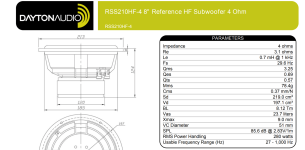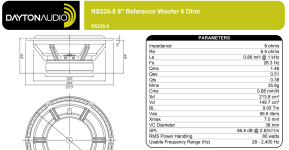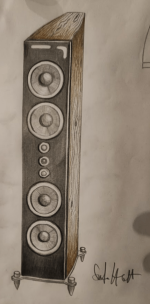Hi, I have started my first speaker build and would like some help.
the idea looks like this, the speakers will be big, 4-ways, they will have active crossing with built-in final stages from icepower.
the construction will look like wwmtmww
the speaker elements that I currently have are:
2x Tweeter: Vifa XT-19 4
4x midrange: Dayton audio RS100 8
4x Midbass: Dayton audio RS225 8
I would like to have subelements that cross roughly around 60-70. I have been looking at the dayton audio RS210 HO/HF. How would two of those work in this setup?
How does the whole idea seem in general? disregard the cost issue, it has no bearing in this case. What I'm interested in knowing from those of you who are pros in the case is if it works?
My concern with the sub elements is that the sensitivity is so different to the other elements, how do you compensate for this?
sorry if the english is a bit weird, i had to use google translate.
the idea looks like this, the speakers will be big, 4-ways, they will have active crossing with built-in final stages from icepower.
the construction will look like wwmtmww
the speaker elements that I currently have are:
2x Tweeter: Vifa XT-19 4
4x midrange: Dayton audio RS100 8
4x Midbass: Dayton audio RS225 8
I would like to have subelements that cross roughly around 60-70. I have been looking at the dayton audio RS210 HO/HF. How would two of those work in this setup?
How does the whole idea seem in general? disregard the cost issue, it has no bearing in this case. What I'm interested in knowing from those of you who are pros in the case is if it works?
My concern with the sub elements is that the sensitivity is so different to the other elements, how do you compensate for this?
sorry if the english is a bit weird, i had to use google translate.
Active speakers simply adjust each amplifier gain to even out the response.
If the amplifiers have no level control, add one before each amplifier.
Usually the bass driver(s) won't need a level control, typically being the least sensitive.
Start with the controls all at maximum, and reduce the gain of the amplifier(s) for the
more sensitive drivers to match the acoustic output of the least sensitive drivers.
If the amplifiers have no level control, add one before each amplifier.
Usually the bass driver(s) won't need a level control, typically being the least sensitive.
Start with the controls all at maximum, and reduce the gain of the amplifier(s) for the
more sensitive drivers to match the acoustic output of the least sensitive drivers.
Last edited:
Where is the woofer to mid XO? I would consider mounting the woofers push-push to take advantage of active reaction force canceletion.. So to add subwoofers you would need 4 woofers.
dave
dave
My plan was to cross the woofers around 70-700 Hz and let the subwoofer drivers handle the deep bottom.Where is the woofer to mid XO? I would consider mounting the woofers push-push to take advantage of active reaction force canceletion.. So to add subwoofers you would need 4 woofers.
dave
Yes 4 subwoofers (dayton RS210) was the plan, 2 in each speaker. WWMTMWW. The subwoofer drivers will be on the top and botton of the speaker in the construction.
My consern with this was the big difference in sensitivity between the subwoofer drivers and the dayton rs225 woofers. I don't really want to pad everything down to the subwoofer level.
Thanks for helping out guys! appreciate it
Attachments
You can cross the RS100 much lower than that. Probably need to get it down to 350-400 Hz to allow for side mounting the woofers. Push-push for a subwoofer is a no-brainer.
Keep in mind that below a certain poin the woofer’s response is omnidirectional.

dave
Keep in mind that below a certain poin the woofer’s response is omnidirectional.

dave
Last edited:
The RS225 are intended as midwoofers…
But why would you cram all that in one enclosure? Ever heard of multi sub or DBA solutions?
But why would you cram all that in one enclosure? Ever heard of multi sub or DBA solutions?
I thought it could be a positive thing? Instead of having several different units in one room.The RS225 are intended as midwoofers…
But why would you cram all that in one enclosure? Ever heard of multi sub or DBA solutions?
I mean, if you can have two speakers that can play as wide a frequency range as possible, it must be good, right? Besides, I like big speakers 🙂
I have not heard of DBA solutions before.
It’s not the speakers that are the problem, it’s the room acoustics you‘ll fix with another approach. Get into knowledge about room modes and the ways to address them.
Yes big speakers are fun.
Could work but good points.
Make D, appalito tweeters and midrange high enough to be at listening level.
Actual sub can be side mounted and low.
Far as subs matching system SPL.
It is active system ,so correct gain is applied.
For less gain or higher sensitivity.
Just move up to larger cone area such as
12" for more efficiency.
Could work but good points.
Make D, appalito tweeters and midrange high enough to be at listening level.
Actual sub can be side mounted and low.
Far as subs matching system SPL.
It is active system ,so correct gain is applied.
For less gain or higher sensitivity.
Just move up to larger cone area such as
12" for more efficiency.
Your most optimum path to success will be to grow your skills and knowledge with a more simple project first, and use it as a test bed, a learning experience. The probability of successfully designing and building a large 4way WWMTMWW system as your first project is about the same as learning to play piano by jumping right into Liszt, Chopin, and Rachmaninoff... or trying to learn woodworking by building a guitar...Hi, I have started my first speaker build and would like some help.
the idea looks like this, the speakers will be big, 4-ways,
Perhaps start with a 2-way system first, learn how to design a cabinet, how to use test equipment and make good measurements... learn how to use your measured data in simulation, and make tradeoffs. Learning these skills are crucial, and many things can only be learned by doing them wrong. It is a lot cheaper to make mistakes with a 2-way design than with a 7-driver 4-way.
j.
1. Take mine and other people's advice - start with something simpler, like a two-way. Do a kit or someone else's design first, and learn things one step at a time.Hi, I have started my first speaker build and would like some help.
My concern with the sub elements is that the sensitivity is so different to the other elements, how do you compensate for this?
2. Since you were talking about an active design, anything is possible here. To adjust the levels electronically is very very simple indeed. As an example, I have a hi-mid driver with more than 20 dB lower sensitivity than the mid-bass.
We all did at some point in our lives and a lot of us built them (guilty, though I maxed out at 160 liter enclosures). Nothing actually stops you from building big, but add separate subs to the equation. A workable solution would be choosing two big mains plus two separate subs with essentially the same build as the low end in the mains but spaced apart in the room. As I said get into knowing the multi sub approach 🤐 Earl Geddes and Floyd Toole would give good starting points.Besides, I like big speakers 🙂
Thanks for all the answers!
Some of you seem to agree that it's better to run WMTMW and separate subs if I understand you correctly?
Other problems that can arise with that method is that it may not be possible to have two subwoofers placed anywhere in the room because of the other furniture as well. But still, maybe that option is still better than adding subs to the speakers?
Some of you seem to agree that it's better to run WMTMW and separate subs if I understand you correctly?
Other problems that can arise with that method is that it may not be possible to have two subwoofers placed anywhere in the room because of the other furniture as well. But still, maybe that option is still better than adding subs to the speakers?
Not maybe. Certainly. And if you will and can afford DSP and individual amping, you can optimize low end response to a flat one in a broad listening area in your room. Read Toole, it will save you a lot of hassle and frustration.
Subwoofers can be really small btw, you correct the response with DSP. 15-20l for those Daytons is certainly possible.
Subwoofers can be really small btw, you correct the response with DSP. 15-20l for those Daytons is certainly possible.
- Home
- Loudspeakers
- Multi-Way
- Help me with my first build WWMTMWW


